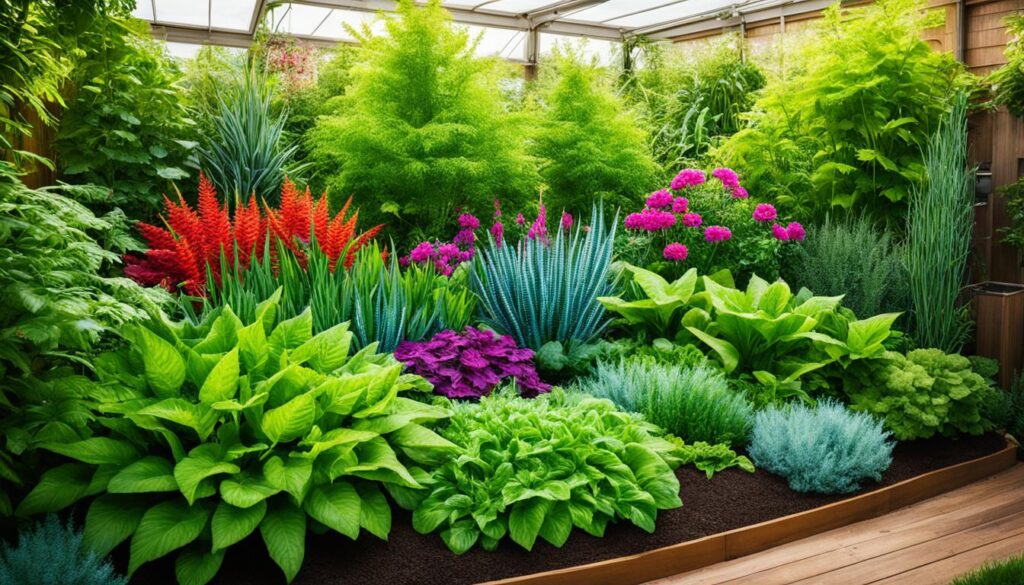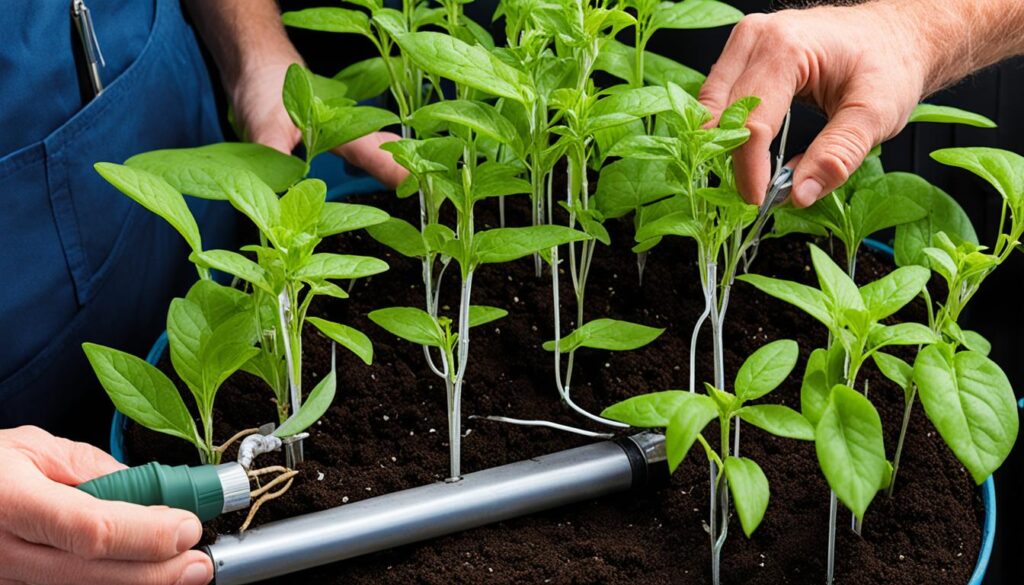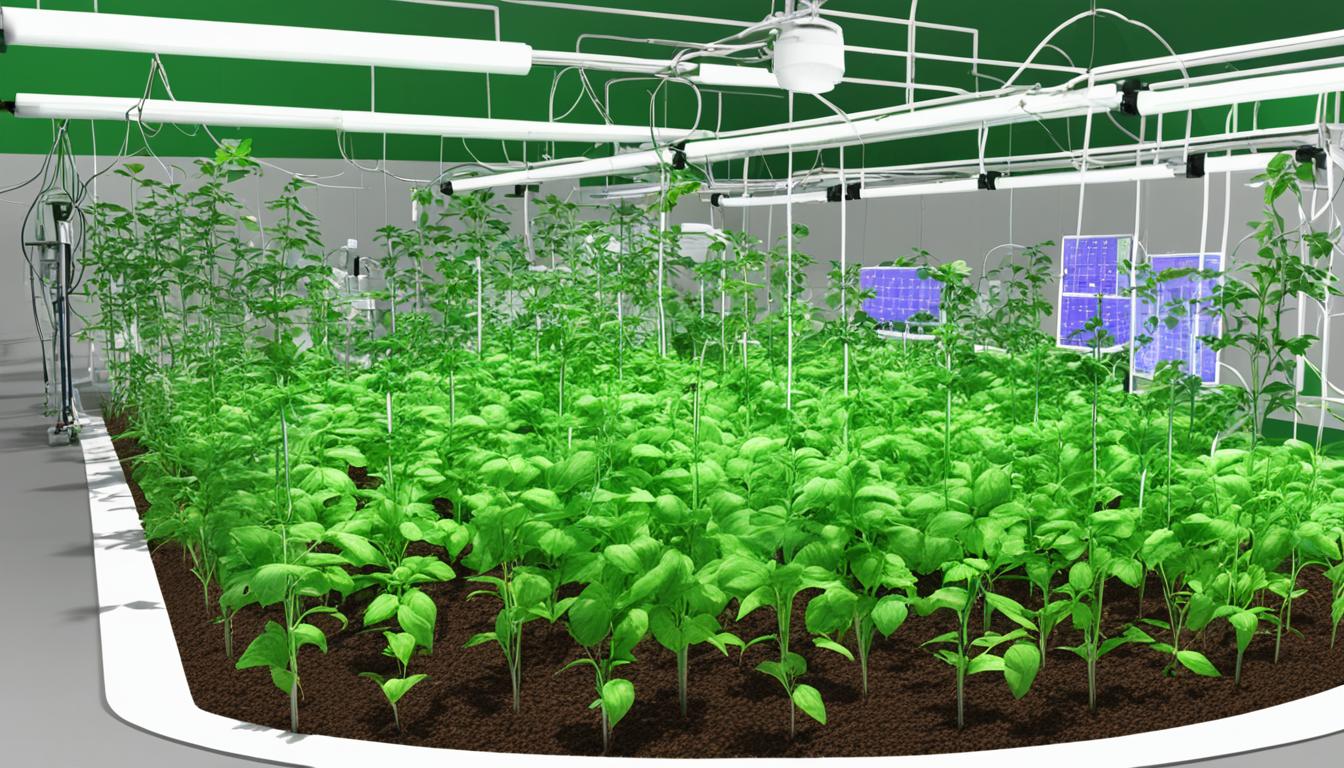This post contains affiliate links.
Imagine your backyard garden in the morning. Dew glistens on vibrant leaves and the air smells like ripe tomatoes and strawberries. This dream can become real with electroculture gardening. It uses electric fields to boost plant growth. This method is changing the way we garden, promising bigger and better harvests.
My garden used to face common problems like bad soil and pests. Then electroculture changed everything. It boosted my garden’s output and I could grow more. Now, we enjoy bigger tomatoes and crisp lettuce regularly. It felt magical.
This mix of tech and green farming is fascinating. Electroculture speeds up growth and reduces environmental damage. It lowers the need for harmful chemicals and saves water. This could be the eco-friendly solution we need. Our food tastes better and has more nutrients, too.
Key Takeaways
- Electroculture gardening can significantly increase crop yield, maximizing space efficiency.
- Stimulation of plant growth leads to earlier harvests and constant fresh produce.
- Fruits and vegetables such as tomatoes and strawberries become larger and sweeter with enhanced flavors.
- Promotes plant health and resilience, reducing the need for chemical pesticides.
- Environmentally friendly approach that conserves water and minimizes soil erosion.
- Strengthens plant immune systems, fostering resilience against environmental stresses.
Electroculture isn’t just a gardening technique; it’s a game-changer. It combines innovation and nature. It’s paving the way for sustainable, efficient, and environmentally friendly gardening.
Understanding Electroculture Gardening
Electroculture gardening is where electric agriculture meets agricultural innovation. It uses electric fields to help plants grow. This idea comes from early experiments in the 20th century. Scientists found that plants could respond to electricity.
Wondering how it all works? Electroculture uses mild electric currents on plants. This leads to big changes in how they grow. It boosts ion transport in plants, which helps them get nutrients better. It also improves photosynthesis. Think back to high school science class. Now, picture ions dancing to an electric beat.
Both home gardeners and small farmers are using this method. They have easier access to the right equipment now. By using sustainable gardening practices, they see healthier plants that grow faster. They can harvest sooner, use fewer pesticides, and help the planet.
Why is this gaining popularity? Facebook groups like Energetic Agriculture have over 150,000 members sharing their stories. On TikTok, #electroculture videos have 97 million views. This shows that many are excited about trying electroculture. Even with some debate, the good stories and promising research are sparking interest.
The best part of using electric current in agriculture is its benefits. It uses less water and reduces soil erosion. Plus, who wouldn’t like better tasting tomatoes and bigger strawberries? It promises a more sustainable way to farm, one spark at a time.
Scientific Foundations of Electroculture
Electroculture gardening is built on complex science. It mixes electric field stimulation with plant growth. This method improves plant growth and health by using bioelectric signals.
Electric Fields and Plant Physiology
Electric fields deeply affect plant life. By using electric stimulation, gardeners make plants grow better and healthier. They can also help plants take in nutrients more effectively.
For instance, antennas made of wood or metals can boost plant yields. They also cut down on water needs and fight against pests. Over time, these methods make the soil richer in nutrients.
Bioelectricity in Plant Metabolism
Bioelectric signals are key to how plants take in and use nutrients. This boosts plant growth significantly. Bioelectricity even helps control plant hormones, aiding their growth.
Materials like copper play a vital role in this process. They’re crucial for things like chlorophyll, which plants need to grow.
Voltage Gradients and Growth Stimulation
Voltage gradients can specifically stimulate plant growth. These can vary based on the crop and the environment. For example, research in Europe and Asia shows electric pulses can increase yields by 20 to 30%.
This method speeds up growth and makes plants stronger against stress. It’s a sustainable and efficient way to garden.
| Electroculture Benefits | Statistics |
|---|---|
| Boost in Pea Germination | 26% |
| Increase in Yields | 18% |
| Copper’s Role in Enzyme Processes and Chlorophyll Formation | Essential |
| Effect of Copper Wire Atmospheric Antennas | Stronger plants, improved soil moisture, reduced pests |
| Impact on Soil Magnetism | More nutrients over time |
The “Energetic Agriculture” Facebook group has over 150,000 members. Interest in electroculture is booming on Google and TikTok. Its proven benefits show its big potential in making farming more sustainable.
Benefits of Electroculture Gardening
Electroculture gardening is changing the way we grow crops, focusing on sustainability. It uses electrical currents to boost plant growth, health, and offers eco-friendly solutions.

Increased Crop Yield
One of the main electroculture benefits is more crops. Innovations let gardeners grow more in the same area. It’s especially great for city farmers with limited space.
Enhanced Plant Health and Resistance
Electroculture makes plants stronger and healthier. They can fight off pests and diseases better. This means we can use fewer chemicals, leading to organic gardening. Happy, healthy plants give us more and better produce.
Sustainability and Environmental Impact
This method matches well with taking care of our planet. It uses clean energy, like solar power, which doesn’t harm the environment. It also saves water and prevents soil erosion. We get more crops without damaging the earth. Electroculture is a win-win for farming and the planet.
In short, electroculture gardening brings many electroculture benefits. From healthier crops to less environmental harm. It’s leading us toward a greener, more productive future in farming.
Setting Up Your Electroculture Garden
Starting an electroculture garden combines technology with the beauty of nature. The first step is to pick the perfect spot. It should get plenty of sunlight and be far from tall buildings that could block the light.
Then, get your soil ready by adding organic materials. Make sure the soil drains well to prevent too much water. This step is key for a successful electroculture setup.
Now, let’s focus on electrifying the garden. You’ll need a good power source. Many gardeners use solar panels or generators. Also, you need electrodes made from materials like copper or zinc. Place them in the soil to spread the electricity evenly.
It’s crucial to have the right controllers. They adjust the electrical inputs your plants get. By following this guide, you’ll smoothly incorporate electroculture into your garden. This can lead to a big, healthy harvest.
| Benefits | Details |
|---|---|
| Increase in Crop Yield | Grow more fruits and vegetables in limited spaces. |
| Reduced Pesticide Use | Enhanced plant health reduces the need for chemical pesticides. |
| Environmental Impact | Minimizes water usage and soil erosion, promoting sustainability. |
| Accelerated Maturation | Stimulates plant growth, enabling earlier crop harvests. |
| Enhanced Flowering and Fruiting | Produces larger and more abundant fruits and vegetables. |
| Disease Resistance | Strengthens plant immunity, reducing the need for chemical interventions. |
| Plant Vitality | Makes plants more resistant to environmental stresses like drought and extreme temperatures. |
| Specific Plant Responses | Tomatoes, strawberries, peppers, lettuce, cucumbers, and spinach thrive with electroculture. |
Essential Equipment for Electroculture Gardening
For growing plants with electricity, you need the right tools. You will need everything from power sources to gadgets for control. Each piece is important for making your electroculture garden great. Here are the key items you need:
Power Sources
Starting your electroculture garden means picking the best power source. Your choices are electrical generators or solar panels for the garden. Both can power your plants well. Generators give steady power. But, solar panels are best for those who like eco-friendly options.
Electrodes and Controllers
The main part of using electricity in a garden is picking good electrodes and controllers. Electrodes are usually made of copper or zinc and move electricity to the soil. Controllers then adjust how much and how often electricity is sent, based on what your plants need.

Soil Preparation and Setup
To get your soil ready for electricity, you need to do a few things. First, add organic stuff to make the soil conduct electricity better. Make sure your soil drains well so it’s not too wet. This helps make electricity work best in your garden.
With the right equipment and knowledge, your garden can do really well. You’ll see more crops, healthier plants, and you’ll garden in a sustainable way. Get ready for the benefits that come with mixing technology and nature in your garden!
Types of Plants Suitable for Electroculture
Not all plants react the same way to electroculture’s exciting effects. But, certain crops do very well in electric gardens. Here are the top picks for an optimal electric plant garden:
- Fruits: Tomatoes, strawberries, and peppers.
- Vegetables: Lettuce, cucumbers, and spinach.
These plants thrive when exposed to electric fields. For example, tomatoes and strawberries grow faster and yield more in electric gardens. They’re among the best choices for fruits.
For greens, lettuce and spinach see big improvements in size and quality. They become ideal for electric gardens. These veggies grow bigger and healthier, needing fewer chemical pesticides.
Electroculture has been shown to boost crop yields beyond traditional methods. It works by electrically stimulating auxins, which helps cells grow. This leads to plants blooming earlier and growing more robustly.
| Plant Type | Best for Electroculture | Benefits |
|---|---|---|
| Fruits | Tomatoes, Strawberries, Peppers | Larger yields, early maturation, enhanced quality |
| Vegetables | Lettuce, Cucumbers, Spinach | Increased size, healthier growth, pest resistance |
Electroculture also improves nutrient absorption, making produce tastier and more nutritious. If you’re looking to dive into electroculture, start with these responsive plants. You’ll see your garden become a high-yield, eco-friendly haven.
Recent Research and Breakthroughs in Electroculture
Electroculture is changing farming for the better. New farming technologies are at the core of this change. They show great results for different crops and places.
Studies on Crop Yield Enhancement
Recent electro agriculture research has made crops grow better. For instance, pulsed electric fields made peas sprout 26% more and increased yields by 18%. Electroculture farming is more nature-friendly because it uses fewer chemicals. Plus, Xunjia Li’s work shows electric fields from the surroundings can make crops grow faster.
Technological Innovations
Electroculture tech is advancing quickly. Copper wire antennas can grab Earth’s energy, boosting plant health. Different electric field methods improve growth, nutrient absorption, and stress handling. These studies are changing crop farming, leading to more produce and healthier plants.
Global Case Studies
In places from Europe to Asia, global electroculture is proving useful. France sees stronger plants and moister soil with special antennas. China uses the tech against bad weather, making crops tougher. These cases show electroculture can change farming worldwide.

Electroculture can make farming better for the planet. It helps increase biodiversity, soil health, and water holding. This boosts plant growth, stress handling, and metabolic rates. Electroculture is key in modern farming methods.
Challenges and Limitations of Electroculture Gardening
Electroculture gardening looks promising but has its challenges. The excitement among garden lovers is clear. Yet, we need to tackle some big issues for it to catch on more.
Scientific Criticisms
The critical analysis of electroculture shows many scientists are doubtful. This idea has been around for over a century. Still, there’s not enough research on how electric fields affect plants. For example, electrified pea seeds germinated faster in one study. But experts say this claim needs more testing to prove electroculture farming works.
Practical Challenges
Facing practical problems can turn gardeners away. Before, using too much energy was a big problem. Now, new technologies like the triboelectric nanogenerator help solve this by using the energy from rain and wind. Yet, putting such technologies in place can be hard and costly. Gardeners often struggle with getting enough power and handling the electrical setup in their gardens.
Future Prospects
Given these concerns and challenges, electroculture farming’s future is uncertain. Progress in technology and more research funding are crucial. As climate change threatens crops, electroculture might be our hope for sustainable farming. By adopting these new methods, our farming could become tougher and more eco-friendly.
| Parameter | Challenges | Solutions |
|---|---|---|
| Scientific Validity | Lack of extensive research | Sustained, rigorous studies |
| Energy Consumption | Initially high energy use | Triboelectric nanogenerators |
| Cost/Implementation | High setup costs | Technological advancements |
Conclusion
Electroculture gardening is a big deal for those who love gardening and innovation. It combines technology with nature to improve how we grow food. It leads to bigger harvests, healthier plants, and it’s good for the planet. Using electrical fields, gardeners can grow more food in less space.
This idea started in the 18th century in France and has been tested over the years. Early tests showed promise, but sometimes it didn’t work out. Now, reports show that electroculture can boost crop yields by 20% to 30%. For instance, a study in China in 2018 proved it. Even mushrooms grow better after lightning strikes, according to a 2020 study in Japan.
Electroculture is more than a simple gardening trick; it could change how we farm. It helps reduce the need for harmful chemicals and makes plants stronger against pests. We still face some hurdles and skepticism, but the research and success stories are hopeful. Electroculture gardening stands as a symbol of innovative and sustainable farming. It shows what we can do when we blend human creativity with nature.
FAQ
What is electroculture gardening?
How does electroculture affect plant growth and metabolism?
What are the primary benefits of electroculture gardening?
What equipment is needed to set up an electroculture garden?
Which plant species respond best to electroculture?
Are there any scientific studies supporting electroculture?
What challenges and limitations does electroculture gardening face?
How does electroculture gardening align with sustainability principles?
This post contains affiliate links.

